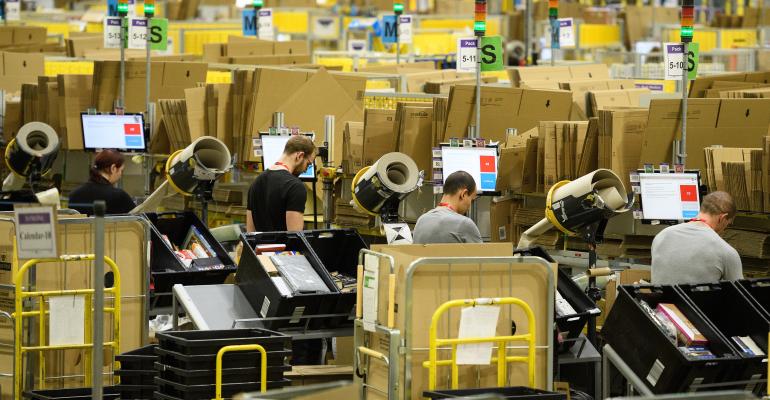(Bloomberg)—A short drive outside Los Angeles lies one of the world’s biggest warehouse complexes. Gene Seroka says its 1.8 billion square feet of capacity -- enough room to house 9 million cars -- is “bursting at the seams.”
The warehouse district is part of the Inland Empire, serving the port of Long Beach and the twin port of Los Angeles, where Seroka is executive director. Together they handle almost half of American’s maritime trade with China. If you live in the U.S., especially the western half, your toothbrush, television or shoes may well have passed through the Empire.
Bloated storage facilities are a consequence of President Donald Trump’s trade war with China and an illustration of how it’s throwing supply lines into disarray, forcing business to improvise. But as the tariffs keep mounting, they’re running out of solutions to avoid them.
Imports have been piling up there over the past year or so -- offering a kind of safety valve for the more than 200,000 U.S. businesses, from Home Depot to Walmart, that use the California ports.
They could rush goods through customs anytime Trump threatened new charges on imports, saving millions of dollars in some cases. Then they could keep the stuff in the Empire until delivery time, sometimes for weeks or months longer than normal.
Now, Seroka says that spare room is down to an unprecedentedly low level of about 1%-2%. Try to squeeze in more stuff, in other words, and it’ll be impossible to drive forklifts around or even walk the aisles.
Sept. 1 Deadline
So companies won’t be able to repeat this cost-saving strategy when the next tariff deadline arrives. And Trump just said it’s less than a month away, on Sept. 1. He tweeted last week that the U.S. will start charging 10% on about $300 billion of Chinese imports that have escaped tariffs so far. The U.S. on Monday formally labeled China a currency manipulator in a rapid escalation of the trade war.
For importers, “the ability to front-load, as they did last year, to a large extent is taken off the table,” said Jock O’Connell, an international trade adviser at Beacon Economics.
It’s not just near ports that storage space is strained, he said. “The surge in imports late last year, driven by anxieties over higher tariffs, coincided with the continued explosion of e-commerce in generating a largely unprecedented demand for warehouse space.”
That’s been a boon to owners of industrial real estate such as Prologis, one of the world’s biggest warehouse landlords and a major owner of space in the Inland Empire. Its shares have soared more than 35% this year.
Sellers have been amassing inventory –- it rose at a 7.9% annual pace in June, the fastest for six years –- and now face pressure to clear it. That’s creating some “head-scratching puzzles,” said O’Connell. He recalls visiting a store in Sacramento during a 95-degree heatwave, and finding winter jackets on prominent display.
The congestion may intensify, as new China tariffs coincide with back-to-school shopping –- and, if Trump escalates them as he’s threatened to do, potentially the holiday season.
The California ports themselves aren’t handling as much shipping as they did last year, when imports surged to a record in the rush to beat tariffs.
California Ports See 2019 Decline
But the pressure on storage space means the system is getting gummed up in other ways, Seroka said. Shipping lines are stuck with empty containers waiting for cargo to export back to Asia, and wait times are long for containers to reach railways and trucks from the shore.
“We’re running pretty fluid now, but it’s not economically fluid,” he said.
While the crammed warehouse reflects short-term strategies adopted by U.S. importers, the ports’ shipping logs reflect what may turn out to be more important long-run effects of Trump’s crackdown.
For example, the drop in arrivals this year reflects a sharp slowdown in China trade –- but traffic with other Asian nations, especially Vietnam, is rising, a trend that pre-dates Trump but may accelerate on his watch.
Outside China, Asian Imports Are Growing
“Last year, it was like ‘Oh my gosh, the tariff is going to hit at the end of the year, let’s get it in,’” said Jason Tolliver, head of Americas logistics and industrial research at Cushman & Wakefield.
Now, he said, companies are asking: “Do we want to manufacture in China, or somewhere else in Southeast Asia?”
--With assistance from Zoe Schneeweiss and Kara Wetzel.
To contact the reporter on this story: Sarah McGregor in Washington at [email protected].
To contact the editors responsible for this story: Margaret Collins at [email protected];
Christopher Palmeri at [email protected]
Ben Holland, Brendan Murray
© 2019 Bloomberg L.P.





